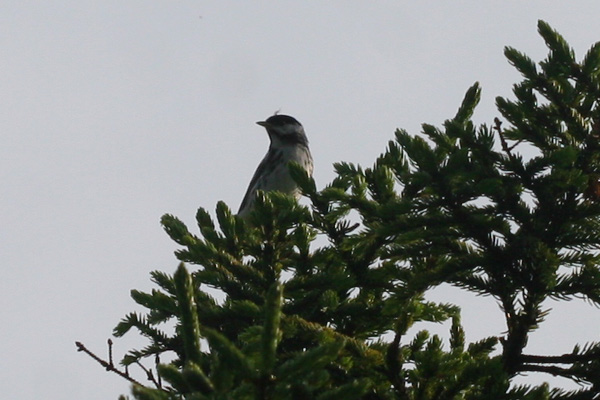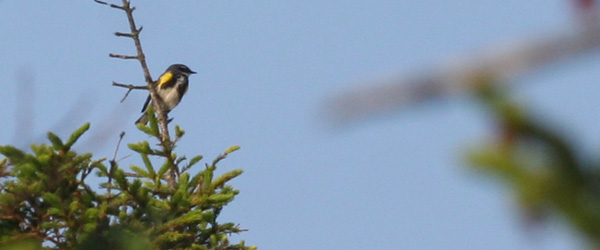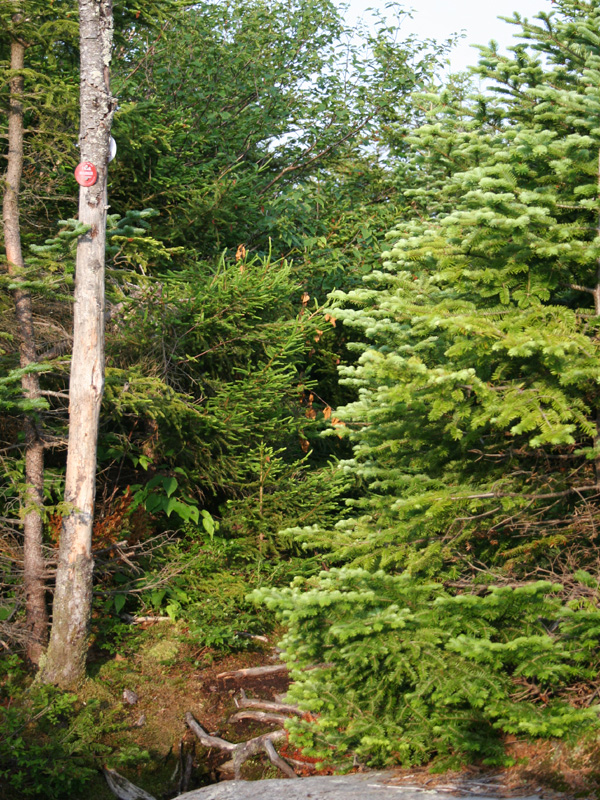This past Monday I burned one of my many vacation days in order to extend my stay upstate long enough for me to hike up a mountain. Like last year’s epic adventure up Wakely Mountain with Mike, Will and Patrick, this hike’s main goal was to track down a Bicknell’s Thrush, the seldom-seen bird that in New York State only nests at the tops of the highest peaks in the Catskills and the Adirondacks. In order to track one down I needed to be at the top of whatever mountain I chose as close to dawn as possible so that I would have a better chance of hearing one sing and following my ears to the bird.
This tendency of the Bicknell’s Thrush to sing at and before dawn explains why I was getting out of my folks’ car at the trailhead to Indian Head Mountain on Predigar Road at 4 AM. I was alone, and, while I’ve hiked alone before and I’ve hiked in the pre-dawn hours of darkness before, I had never combined both to do a solo hike in the dark. It was kind of scary to be perfectly honest!
But within a minute of starting down the trail a Barred Owl started hooting off and on and I found that if I paid attention to the hooting I didn’t think about things like bears or axe-murderers stalking me through the woods. My head lamp, which makes me look like a spelunker minus the hard hat, kept the trail ahead of me well-illuminated and I managed to successfully navigate all the way to Jimmy Dolan’s Notch before dawn, accompanied by the wonderful sounds of singing Hermit Thrushes. At the notch, which is the low point between the adjacent peaks of Indian Head Mountain and Twin Mountain, I put my head lamp in my backpack and made the final ascent in one push, arriving in the gorgeous evergreen forest on top of Indian Head Mountain where a Bicknell’s Thrush sang to me from a branch just off the trail. I got good looks but there was just not enough light yet for pictures, and, once again, an expedition for Bicknell’s Thrush would leave me extraordinarily satisfied with the looks I got but without a picture to share.
Fortunately, Bicknell’s Thrush is not the only bird that makes the mountaintop home and I was pleased to once again make the acquaintence of wood-warblers that were last glimpsed by me as they sped north on migration. Blackpoll Warblers sang their high-pitched songs from treetops and Yellow-rumped Warblers flitted from tree to tree, foraging for food. I was never out of earshot of a singing Winter Wren though I only managed to actually see one in the thick vegetation. Dark-eyed Juncos were everywhere, both adults and juveniles, twittering away and flashing their white tail feathers in retreat whenever I came too close as I moved along the summit. It was an enjoyable hour or so on top of a mountain that I had all to myself, with only an occasional airplane to remind me that I wasn’t the last person left on earth.
Blackpoll Warbler
Yellow-rumped Warbler
Odd birds for the summit included two Mourning Doves, which I had never had at that elevation (3,573 feet), a Ruby-throated Hummingbird, and a small flock of Cedar Waxwings that seemed to be just passing through. I did not see a single Red Squirrel at the summit (I think that they are in the bust part of their boom-and-bust population cycle) and only spotted a couple Yellow-bellied Flycatchers.
Just before leaving to hike back down from the top of the mountain I was sitting on a rcoky outcrop enjoying the foraging behavior of a Blackpoll Warbler when I heard something that made me turn my head. A Bicknell’s Thrush was sitting on a branch in perfect light almost within arm’s length. The staredown lasted less than three seconds I’m sure but it felt like an hour. Then the bird dropped off the branch and disappeared. Those three seconds alone made the hike worthwhile!
The hike back down was nearly a total disaster as my legs were starting to feel rubbery and at one point my center of gravity shifted dangerously forward. I managed to keep my legs under me for two rapid steps downhill and looked up to see a rather large sapling in my way. I tucked my camera like a football under my right arm and grabbed onto the tree with me left and managed to stop myself by half swinging on the tree and half falling down. Fortunately I managed to miss the many large rocks and after a moment or two of getting myself together continued down the mountain.
And the hike down was loaded with more warblers: Black-throated Blue, Black-throated Green, Blackburnian, American Redstart, and Ovenbird. Red-eyed Vireos would not shut up and the occasional Blue-headed Vireo was easy to pick out by their slightly different song. But the highlight coming down the mountian was definitely a rather large bear that I only saw as it rushed through the woods away from me at a high rate of speed. By the time I realized what it was it was too far away for me to be worried about it. I’m just glad that it was on the way down that I saw the bear: if I had heard that kind of crashing in the undergrowth on my way up the mountain in the dark I’d have turned tail and ran!
I was back at my parents’ house at just after 10 AM, a perfect time for a dip in their pool!














Great walk, Corey – enjoyed it!
Cheers, Klaus
Indian Head Mountain is one of the Catskills finest peaks. It offers great views and a wide variety of wildlife, especially noticeable in winter.
For those wanting to learn more about Catskill High Peak hiking visit the Catskill 3500 Club Website. Joining the club as an aspirant you can go on club outings and hike all the high peaks with other like minded folks.
Thanks Klaus…
And thanks for the info Scott.
Excellent! Yes I do the same sorts of pursuits for the same reasons. Was on Peekamoose late may this year (2008); got some good looks at c. bicknelli.
Got some good looks and listens at Bicknells up on Plateau yesterday, late morning, overcast and cool. Also plenty of Blackpolls, Winter Wrens non-stop, Vireos etc. that you saw on your hike on Indian Head. As well as Swainson’s Thrush and Yellow-Bellied Flycatcher.